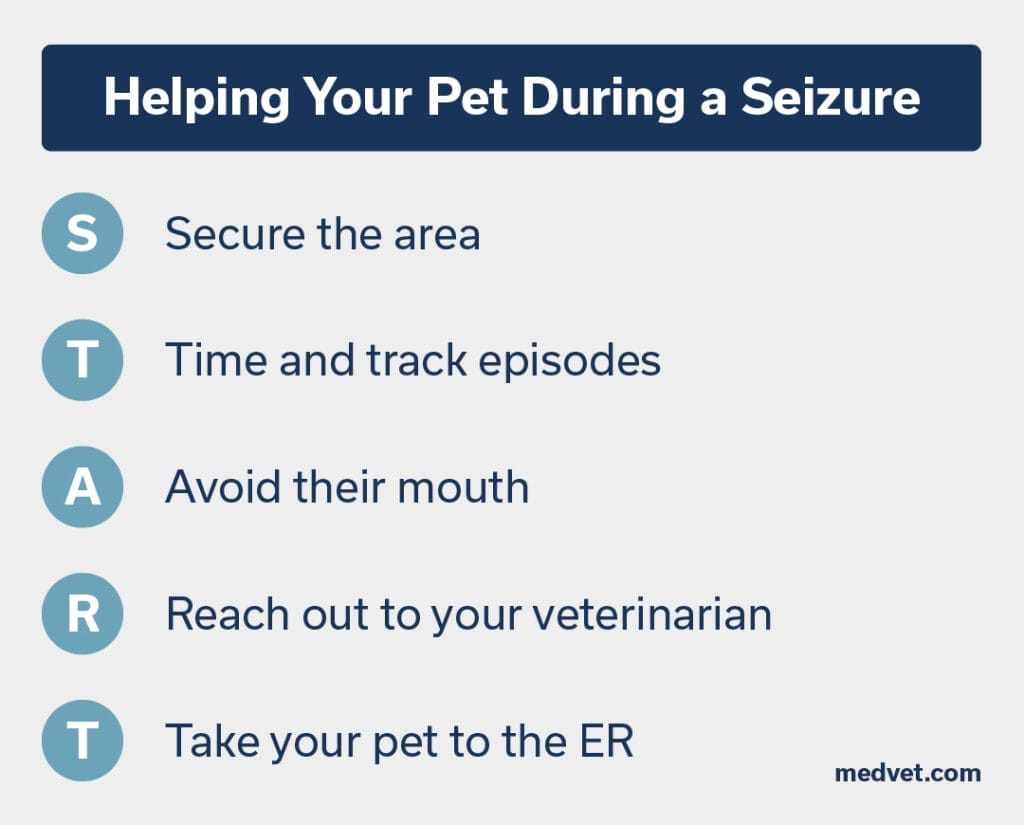Neurology & Neurosurgery, Emergency Medicine
Seizures in Pets – Knowing the Signs and What to Do
The brain is amazing. It houses an extraordinary number of electrical impulses and trillions of connections controlling everything in the body. With so many connections, it’s not surprising that sometimes there can be a misfire. Such abnormal electrical activity in the brain causes seizures in pets.
Seizures can occur from an issue outside the brain (metabolic) or an issue inside the brain. Issues outside the brain may include ingesting a toxic substance, liver or kidney disease, or electrolyte disturbances. If these problems have been ruled out, looking for an issue inside the brain is the next step. Idiopathic epilepsy is a common condition in dogs and some cats that causes them to have repeated seizure episodes. These seizures are unpredictable and can vary in severity and frequency. Lastly, problems inside the brain like encephalitis, stroke, or a brain tumor, are also possible causes of seizure.
Experiencing a seizure can be scary for you and your pet but knowing what to look for and how to react can help.
How do I know my pet is having a seizure?
If you were asked to describe someone having a seizure, most likely you would first think about someone convulsing or shaking uncontrollably. However, that’s not always the case. There are three main categories of seizures. A grand mal seizure is the easiest to spot. This is more generalized and typically affects the entire body. A focal seizure only affects part of the brain and resulting erratic movements can be limited to the face, one side of the body, or one limb. There are also psychomotor seizures where instead of a collapse or shaking, your pet may start to repeat an odd behavior. At first, it may seem like your pet is just being silly (like a case of the “zoomies”), but with seizures, it is often the same odd activity repeated.
If your pet is having a seizure they may:
- Become unsteady and have trouble walking or balancing
- Chomp or make biting motions
- Collapse, fall to the side, or stiffen
- Foam at the mouth or drool
- Look confused or dazed and then drop to the floor
- Lose consciousness
- Lose control of body functions and urinate or defecate
- Shake, jerk or twitch, sometimes laying on their side and kicking their legs almost as if they are treading water
- Repeat an odd behavior
After a seizure, they may have a hard time seeing, walk in circles, seem unsteady, or even try to hide from you. If your pet regularly has seizures, you may notice warning signs in advance like your pet seeming anxious or dazed.

How can I help my pet during a seizure?
The most important thing you can do is remain calm, which can certainly be a challenge when you’re worried about your pet’s health, safety, and wellbeing. Although seizures are typically over in a matter of minutes, it can seem much longer for a concerned pet parent. Remember, your pet is counting on you for help, so follow the START method’s five steps below.
S – Secure the area
A big concern with seizures is that your pet can end up getting injured during an episode. There is no need to restrain your pet. You should move them away from anything that can cause harm like stairs, bodies of water, furniture, or hard objects with sharp angles or edges. You may also try to cushion their head if they are on a hard surface like a wood or concrete floor. Keep other pets and children away from the pet seizuring to avoid inadvertent injury.
T – Time and track episodes
If possible, time the seizure and track how often your pet experiences the seizures or use your phone to record a video. Sharing this important information can help your veterinarian as they diagnose your pet and provide appropriate treatment options.
Related to the duration of the episode, most seizures end in about two to three minutes. If a seizure lasts longer, then it should be treated as an emergency. The general rule of thumb is that longer than five minutes of convulsing is an emergency situation. If you factor in the time it takes to get to an emergency facility, we recommend getting your pet in the car to bring to an emergency facility if the seizure does not stop on its own after the first three minutes.
A – Avoid their mouth
A common misconception about seizures is that your pet can swallow their tongue. However, that will not happen, so you should not reach into their mouths for any reason. Seizuring pets are typically unconscious, meaning they are not aware of anything, and their chomping behavior can result in severe bites. It is okay to be next to them, but steer clear of their head and mouth for your own safety.
R – Reach out to your veterinarian
Contact your primary care veterinarian or emergency clinic immediately as instructed by your veterinarian.
T – Take your pet to the nearest emergency clinic
You should bring your pet to the nearest ER if your pet has a seizure that lasts for 5 minutes or longer, has 3 or more seizures within a 24 hour period, or unable to return to a normal state in 3 hours.

When is a seizure an emergency?
If your pet has a seizure for the first time, they should be evaluated as soon as possible. Additionally, a seizure is an emergency if there are multiple seizures in a row or if a seizure lasts longer than five minutes without stopping. Seizures like these can become life-threatening if not treated, and you should seek emergency treatment if this occurs.
What are the treatments for seizures in pets?
Treatment typically starts once a pet has had more than one seizure in a period of several months, if there is an underlying brain disease, or if they experience severe, prolonged, or clustered seizures. Your veterinarian will examine your pet and run tests to help determine if there is an underlying cause for the seizures. Sharing information about the frequency and length of episodes will help your veterinarian with the diagnosis and treatment. Testing may include blood and urine tests, chest x-rays, and possibly a brain MRI to gain a more complete picture of what’s happening in your pet’s brain. Keep in mind that pets need to go under general anesthesia to have an MRI, since we cannot tell them to stay still.
If an underlying cause is found, treatment will address that condition. In many cases, once addressed, seizures will decrease in frequency and severity. If your pet is diagnosed with idiopathic epilepsy (recurring seizures without any other brain issues), there is no cure. However, daily medications can decrease the frequency and severity of seizures. Once medication begins, your pet will remain on it for the rest of their life with a focus on providing the best quality of life possible.

How can I help keep track of my pet’s seizure control?
The best way to stay on top of your pet’s health if they have recurrent seizures is to keep a seizure log. This can be tracked at home and brought to all follow-up appointments. You can also contact your veterinarian between appointments if you notice that your pet’s seizures are getting worse. A sample seizure log is provided here, but you can use any type of log that works best for you.